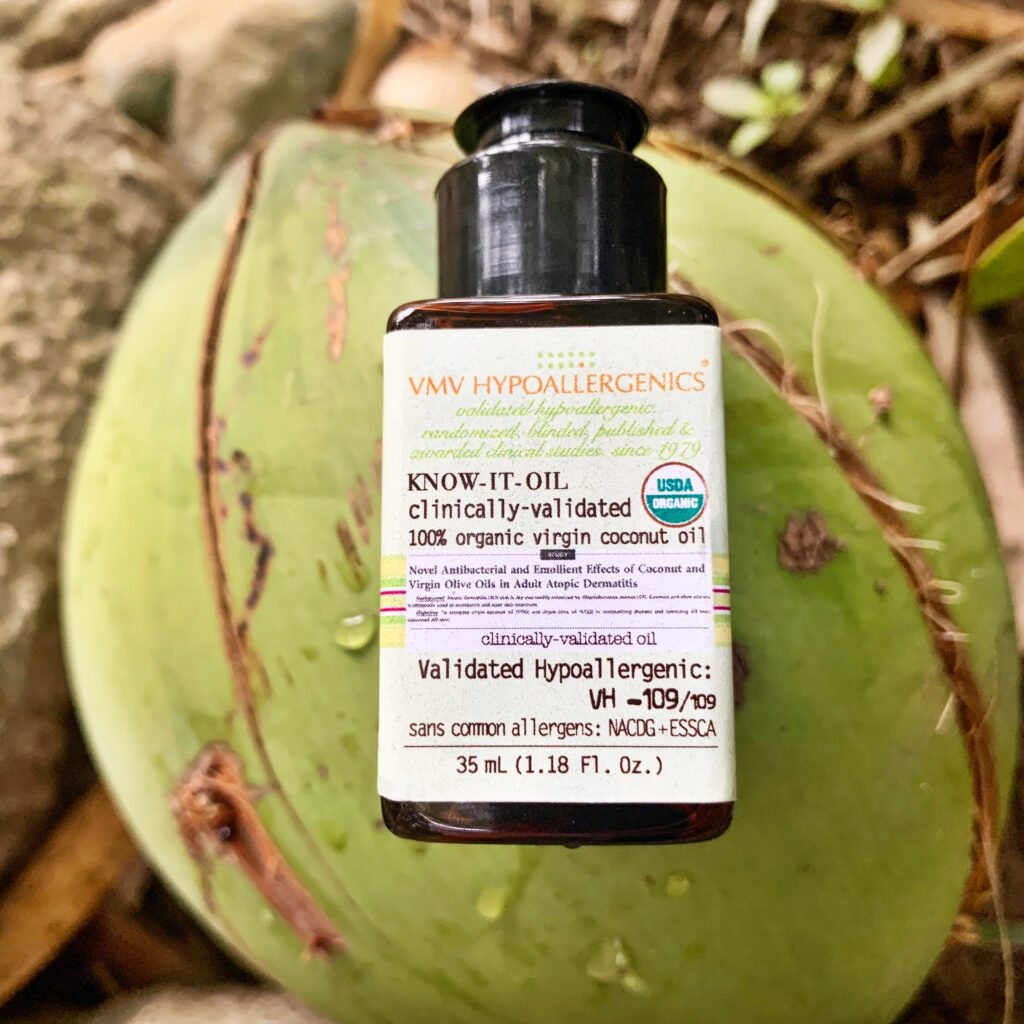If You Can’t Eat It, You Can Probably Still Use It In A Cream.
“I’m allergic to almonds…can I use a cream with an ingredient extracted from almonds?” “I can’t eat coconuts…that means I can’t use coconut oil, right?”
If you have prick tested positive to something, it is more likely than not that you can still use it on your skin.
The main reason is that, while complex, skin and other allergies involve such different cells, systems, and modalities.
Quick Breakdown
There are 4 types of reactions that we tend to have. Type 1 and Type 4 are most relevant to prick tests and patch tests.
Type 1: asthma, naso-bronchial allergies, pets, dust mites, pollen, and food
- Is IgE-mediated and involves antibodies.
- Is what a lot of us think of when we think about an allergic reaction (the trouble breathing (anaphylaxis), puffing up, urticaria, etc.
- While there can be some delayed responses, always something happens quickly — within 60 minutes. This reaction is very straightforward because it is IgE mediated and IgE exists in the body.
- Food is included here but is more complicated (see below)
Type 4: contact dermatitis
- Is non-IgE mediated and does not involve antibodies.
- It is T-cell mediated.
- The response is not immediate as with Type 1. It is delayed because there is more of a process. There has to be a sensitization that then triggers a reaction to occur. This can take a week to many weeks.
- Instead of being IgE-mediated, this is T-cell mediated.
Food Reactions Can Be More Complicated
Food reactions include…
- IgE-mediated: e.g. strawberries, peanuts
- Non IgE-mediated: food protein-induced enterocolitis, which is T cell-mediated, does not happen immediately, and is usually outgrown, such as when a baby is allergic to the protein found in cow’s milk.
- Non-allergic reaction which is metabolic: such as when you don’t have the enzyme needed to break down sugar lactose, i.e., you’re lactose intolerant).
- Food allergies can be difficult to isolate because there can be many substances at play in one food. This is especially true for drugs. Drugs are made up of so many compounds so it is very difficult to isolate the trigger. This is why drug IgE testing is rare and very hard to distinguish. On the other hand, an allergy to a drug with skin manifestations can be patch tested.
- Other food reactions include:
- Adverse reaction (non-immune mediated)
- Toxic (puffer fish toxin)
- Conditions like Irritable Bowel Syndrome, which is not an allergy but has the same symptoms.
Where It Gets More Complex for Skin: Atopic Dermatitis
Atopic dermatitis is a different type of allergy with many theories still being explored. Inheritance plays a factor. One theory is regarding the presence of over-reactors — in which case, an over-reaction to food may also occur. And contact dermatitis is frequently a factor.
There is also “atopic march”: if you had eczema as child, you could be more likely to have asthma and naso-bronchial allergies as an adult.
For more on atopic dermatitis (eczema), check out What Is Eczema.
What To Know If You Have Skin & Food Allergies:
1. A prick test is for IgE, involves antibodies, and can be more complicated. Even if you prick test positive to shellfish, for example, your allergist needs to correlate the findings with your history to determine if you really cannot eat shellfish.
2. A patch test is very straightforward: If you patch test positive to something, contact with it will be a problem.
3. If your prick test is positive for something — unless you ALSO patch test positive to it — you can probably use it on your skin because the modalities and systems are so different. For example, if you prick test positive for almonds, the chances are very high that you can use a product on your skin with an ingredient extracted from almonds.
3. If you patch test and prick test positive to something, you need to avoid it in food and in your skin. For example, if you patch and prick test positive to nickel, you’ll react to it when touching it and if it is in your food.
Which Test To Get, and From Which Doctor?
For a patch test, see a dermatologist. For a prick test, see an allergist.
Some allergists do patch testing, too. But if you have a long history of stubborn skin reactions, we’d suggest seeing a dermatologist who is a contact dermatitis specialist for your patch testing. They are…specialists! They would have more patch test tray options, can really help identify what you need to avoid, and can identify other possible skin conditions that may also need to be managed. If you also have non-skin allergies, your contact dermatitis specialist can work closely with your allergist.
How to find such a doctor?
- In the USA: search contactderm.org. You can search by zip code and members of the American Contact Dermatitis Society also use CAMP (the Contact Allergen Management Program) to show you not just the ingredients and substances you need to avoid but brands and products that you can use (where you’ll see VMV Hypoallergenics a lot!)
- In the Philippines: PM VMV Skin Research Centre + Clinics, where patch testing is a specialty.
- In other countries: ask your official dermatological society about local contact dermatitis experts who offer patch testing.
How Else VMV Hypoallergenics Can Help?
Ask us to customize recommendations for you based on your patch test results and even possible cross reactants.
Otherwise, use the VH-Rating to shop safely for VMV products! Check out this helpful video on how it works.
At VMV, we make it easy to be guided by your patch test.
1) We practice allergen ommision
As our basis for what to omit, we refer to studies by independent groups of doctors who specialize in contact dermatitis, such as the North American Contact Dermatitis Group and European Surveillance System on Contact Allergies. They regularly publish top contact allergens based on thousands of patch tests done in multiple countries.
2) We do our own patch testing…
…not just of the final formulation but also of each ingredient, raw material, and applicators (and we do allergen reviews of packaging, too).
3) Our VH-Rating System shows how many of the top contact allergens are NOT in a formulation.
If an allergen is included, the VH-Rating is lower and marked by an asterisk which corresponds to the ingredients list — you’ll see the allergen clearly marked with the asterisk and underlined, too. If they’re not allergens that you patch tested positive to, you can still use the product.
The VH-Rating System has been so effective that a clinical study published in a leading contact dermatitis journal showed less than 0.1% reactions reported in over 30 years.
4) We manufacture our own products.
We can ensure that our formulations are not mixed, stored, or handled in containers used for formulations with allergens, or otherwise contaminated by allergens.

Laura is our “dew”-good CEO at VMV Hypoallergenics and eldest daughter of VMV’s founding dermatologist-dermatopathologist. She has two children, Madison and Gavin, and works at VMV with her sister CC and husband Juan Pablo (Madison and Gavin frequently volunteer their “usage testing” services). In addition to saving the world’s skin, Laura is passionate about health, inclusion, cultural theory, human rights, happiness, and spreading goodness (like a VMV cream!)







